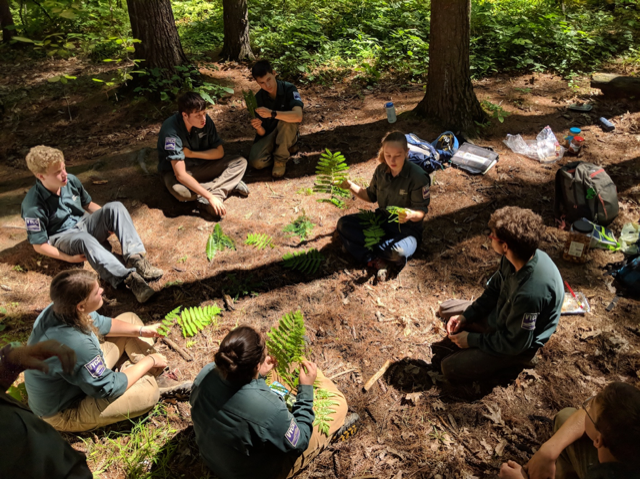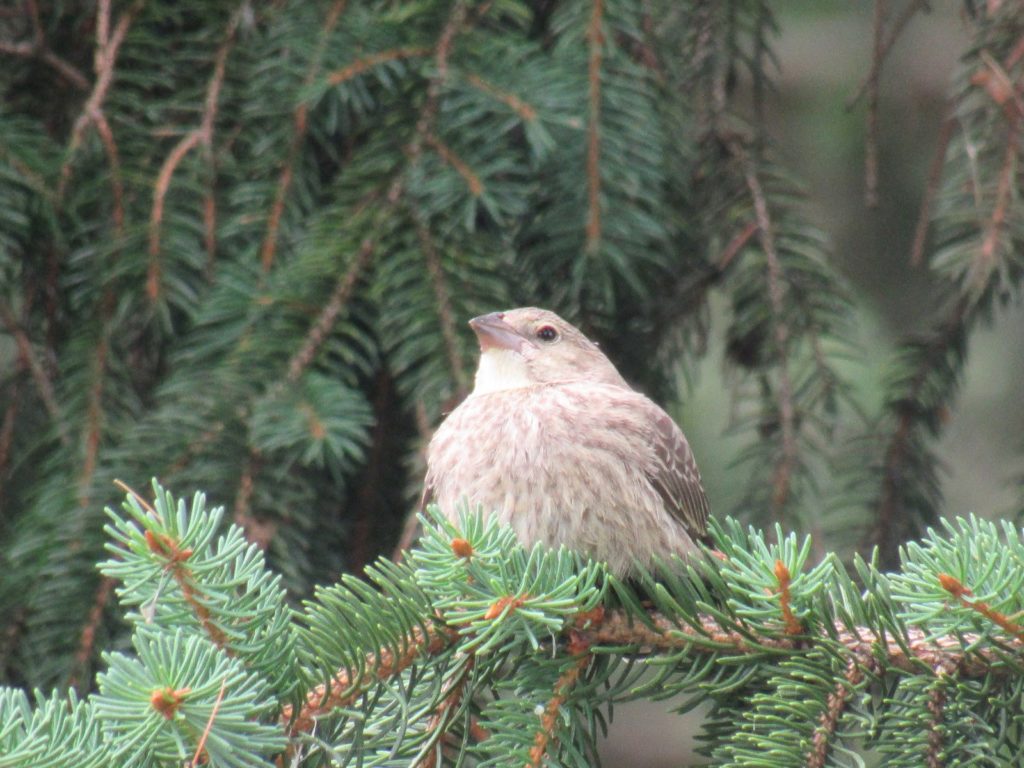VYCC Trail Work: Not a Walk in the Park

Vermont Youth Conservation Corps is a nonprofit organization dedicated to conservation, agricultural work, and youth development in Vermont. Teenagers and young adults (ages fifteen through twenty-four) are guaranteed a unique and memorable opportunity to give back to their communities while learning how to work productively as a team and build lasting friendships. During the summer, two kinds of VYCC crews are at work: community crews work locally during the day and spike crews camp overnight near their worksites in different locations around the state. Here is a report from Hannah Frasure who worked on the crew stationed in Burlington this past summer.
During our time together, crew leaders Jacob Kroes and Emily Anderson led members through projects at three different locations. The crew began work at Arms Park, resuming a project that had been started by members of the first session. A 27’-long bridge had to be constructed over a dip in the land as part of a plan to make a trail which could be certified as handicap-accessible. After we dug up the ground, we placed wooden footers, meticulously levelled them, and secured them with a mixture of dirt and gravel called sure pack. We then secured three wooden stringers to the sills and placed wooden posts at three-foot intervals. Lastly, we screwed decking over the top. By mid-afternoon Wednesday, we had finished.
Each day, there is an hour allotted to the educational component of VYCC. We were visited by Burlington field naturalist, Alicia Daniel, who taught us about the interesting geographical background of the area. She also identified for us an extremely rare species of sand-dwelling plant, a type of spikerush, which only grows in a select few locations globally, including the shores of our very own Lake Champlain. Learning of such a treasure that is found here should only deepen our respect and admiration for our home state.
Our next project took place at Rock Point, redoing a series of puncheons along a wet trail. Puncheons also known as bog bridges are bridge-like structures built close to the ground in soggy wetland areas, built to prevent trail erosion and to ensure that trails are still accessible even when the ground has become muddy and unsafe.
The surprisingly tough process begins by transporting materials to the worksite, which include four-foot wood sills (weighing much more than one would think) and wheelbarrows full of sure-pack. Next, measurements are made and three 4’-long holes, approximately are dug over a span of 7’ (leaving a 6” overhang on either end of the puncheon). Then, comes the tedious process of levelling. Working in teams of two or three people per punch-in, we take turns bringing buckets of sure-pack over to the holes and pouring it in. Dirt compresses easily, so the sills could sink over time if sure-pack is not used.
Afterward, a sill is typically placed in the middle hole, that position being the easiest point for reference. We use a level to check if it is unbalanced on one side or the other, or if it looks too low, we add more sure-pack. A tool called the single jack (essentially, a mini-sledgehammer) is used to crush the sure-pack as a precautionary measure because if not fully packed, the puncheon could eventually become unlevelled due to the traffic of trail-goers over time. Then, the steps are repeated with the next two sills in addition to the fact that they must also level with the initial middle one.
Finally, stringers are screwed on top of the sills, and the puncheon has been completed. Amazingly, during our couple of weeks at Rock Point, we managed to build a series of puncheons which spanned 645’. Depending on the slope of the soil, it can sometimes take up to a day to complete a single puncheon. Otherwise, each team typically finishes two or three puncheons each day.

We also spent a week at the Mount Cavalry Red Maple Wetland, stabilizing old puncheons and building new ones.
All in all, conservation work is a far cry from the picture that is often painted of it. It is an extremely physical and labor-intensive job which yields actual, practical results. The dedication it requires teaches those of us on the crew about the meaning of personal responsibility. You are directly accountable for your actions. For example, each crew member is given the opportunity to be crew leader for a day. If you remain highly focused on the task at hand, you will inspire others to do the same, and you can efficiently delegate tasks to your productive coworkers. On the other hand, if you don’t adequately crush the sure pack before levelling, your teammates have to compensate for your mistake and you’ll have wasted the crew’s time.
The most important wisdom one can learn from VYCC is this: if you come into work with a positive attitude, knowing that your work is vitally important to the crew, you will feel valued and that affirmation maximizes your productivity because you’ve dedicated yourself to becoming the best worker you can be.
Ultimately, the conservation story is a microcosm in which the moral transfigures. We are all accountable for our footprint upon this Earth, for better or for worse. On behalf of the Burlington Community Crew, we would like you to read Daniel Quinn’s “A Path for the Hope of the Future”. It was the keynote address from 2000 at the Houston Youth Environmental Leadership Conference, but its one-of-a-kind message of our innate potentiality as humans, still stands today. Once you have finished, send it along to another person.
As one crew member pointed out, we care more about Yosemite than our own backyard. Another had observed that so many Vermonters have a love for the woods but aren’t sure what to do with it.
For many of us, it’s extremely saddening when we find beautiful Vermont woods laden with trash; while working at Cavalry, one crew member spent two whole days cleaning up the debris that had most likely came in with stormwater from the drainage pipe, a problem that could easily be fixed in the future if someone simply put a capture net over it.
Perhaps, having read this article, you will have a newfound appreciation for the hard work that many people have put into the trails wherever you walk. We hope that you will feel even more connected to the land, of its invaluable beauty and usefulness, and that you will do everything within your power to be a good steward. Whether that is picking up a piece of a trash along a path, or supporting organizations like ours, you are always a citizen of this planet no matter how old or young, and you are responsible for choosing to do the right thing for our environment.
In the meantime, please feel free to check out some of those parks that have been mentioned! Those puncheons are eager to be walked on.
Feature photo: shows crew members during the education period identifying different types of ferns found at the Rock Point forest. (In order of the circle starting from farthest right: Ethan Hobbs, Kyle Sizemore, Hannah Frasure, Ethan No, James Cortina, Will Beluche, Sadie Everett, Mackenzie Giroux)
